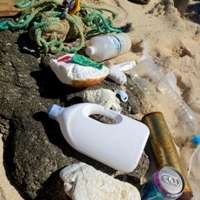Each square kilometre of Australian sea surface water is contaminated by around 4000 pieces of tiny plastics that could affect humans as well as marine life according to researchers from The University of Western Australia and CSIRO Wealth from Oceans Flagship.
Their study published in the international journal Plos One reported the plastic particles were mostly a result of the breakdown of disposable packaging and fishing gear made of polyethylene and polypropylene. These two polymers are commonly used to make everyday items, such as water bottles and plastic cups.
Lead author and PhD student Julia Reisser, from UWA's Oceans Institute, said the plastics detected during the at-sea surveys could contain hazardous materials as well as pollutants absorbed from surrounding waters.
"There is increasing evidence that marine animals, ranging from plankton to whales, ingest large amounts of plastics loaded with pollutants, which may then be incorporated into the food chain," Ms Reisser said.
Previous studies have detected microplastics in the stomachs of southern bluefin tuna captured close to Tasmania and destined for human consumption. This means marine plastic pollution may be harmful to humans too.
The study provides the first map of the distribution of floating marine plastics in Australian waters. Winthrop Professor Charitha Pattiaratchi, who supervised Ms Reisser, said hotspots of plastics had been found offshore near highly populated areas as well as in regions where ocean currents converged.
Ms Reisser said results of the study demonstrated it was vital to take action to reduce marine pollution.
"We need to decrease plastic waste and toxicity, regulate plastic disposal on land at an international level, and better enforce the laws prohibiting dumping plastics at sea."
More information: www.plosone.org/article/info%3Adoi%2F10.1371%2Fjournal.pone.0080466
Journal information: PLoS ONE
Provided by University of Western Australia
























